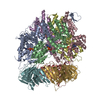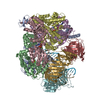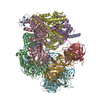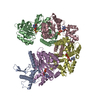[English] 日本語
 Yorodumi
Yorodumi- PDB-8umt: Atomic model of the human CTF18-RFC-PCNA binary complex in the th... -
+ Open data
Open data
- Basic information
Basic information
| Entry | Database: PDB / ID: 8umt | ||||||
|---|---|---|---|---|---|---|---|
| Title | Atomic model of the human CTF18-RFC-PCNA binary complex in the three-subunit binding state (state 2) | ||||||
 Components Components |
| ||||||
 Keywords Keywords | REPLICATION/DNA / DNA clamp loader complex / REPLICATION-DNA complex | ||||||
| Function / homology |  Function and homology information Function and homology informationpositive regulation of deoxyribonuclease activity / dinucleotide insertion or deletion binding / PCNA-p21 complex / response to organophosphorus / Ctf18 RFC-like complex / mitotic telomere maintenance via semi-conservative replication / Rad17 RFC-like complex / DNA replication factor C complex / Elg1 RFC-like complex / purine-specific mismatch base pair DNA N-glycosylase activity ...positive regulation of deoxyribonuclease activity / dinucleotide insertion or deletion binding / PCNA-p21 complex / response to organophosphorus / Ctf18 RFC-like complex / mitotic telomere maintenance via semi-conservative replication / Rad17 RFC-like complex / DNA replication factor C complex / Elg1 RFC-like complex / purine-specific mismatch base pair DNA N-glycosylase activity / nuclear lamina / MutLalpha complex binding / positive regulation of DNA-directed DNA polymerase activity / Polymerase switching / Telomere C-strand (Lagging Strand) Synthesis / Processive synthesis on the lagging strand / DNA clamp loader activity / PCNA complex / Removal of the Flap Intermediate / Processive synthesis on the C-strand of the telomere / Mismatch repair (MMR) directed by MSH2:MSH3 (MutSbeta) / Polymerase switching on the C-strand of the telomere / Mismatch repair (MMR) directed by MSH2:MSH6 (MutSalpha) / Transcription of E2F targets under negative control by DREAM complex / Removal of the Flap Intermediate from the C-strand / replisome / DNA duplex unwinding / single-stranded DNA helicase activity / response to L-glutamate / HDR through Single Strand Annealing (SSA) / Impaired BRCA2 binding to RAD51 / DNA strand elongation involved in DNA replication / histone acetyltransferase binding / DNA synthesis involved in DNA repair / DNA polymerase processivity factor activity / G1/S-Specific Transcription / leading strand elongation / response to dexamethasone / replication fork processing / nuclear replication fork / Presynaptic phase of homologous DNA pairing and strand exchange / SUMOylation of DNA replication proteins / estrous cycle / PCNA-Dependent Long Patch Base Excision Repair / cyclin-dependent protein kinase holoenzyme complex / ATP-dependent activity, acting on DNA / mismatch repair / translesion synthesis / Activation of ATR in response to replication stress / response to cadmium ion / DNA polymerase binding / epithelial cell differentiation / positive regulation of DNA repair / Translesion synthesis by REV1 / Translesion synthesis by POLK / Translesion synthesis by POLI / Gap-filling DNA repair synthesis and ligation in GG-NER / base-excision repair, gap-filling / TP53 Regulates Transcription of Genes Involved in G2 Cell Cycle Arrest / replication fork / positive regulation of DNA replication / male germ cell nucleus / liver regeneration / nuclear estrogen receptor binding / Recognition of DNA damage by PCNA-containing replication complex / Termination of translesion DNA synthesis / Translesion Synthesis by POLH / G2/M DNA damage checkpoint / HDR through Homologous Recombination (HRR) / Dual Incision in GG-NER / DNA-templated DNA replication / receptor tyrosine kinase binding / cellular response to hydrogen peroxide / Dual incision in TC-NER / Gap-filling DNA repair synthesis and ligation in TC-NER / cellular response to UV / cellular response to xenobiotic stimulus / E3 ubiquitin ligases ubiquitinate target proteins / response to estradiol / heart development / Processing of DNA double-strand break ends / DNA replication / Regulation of TP53 Activity through Phosphorylation / chromosome, telomeric region / damaged DNA binding / nuclear body / cell cycle / DNA repair / centrosome / chromatin binding / protein-containing complex binding / chromatin / enzyme binding / negative regulation of transcription by RNA polymerase II / ATP hydrolysis activity / DNA binding / extracellular exosome / nucleoplasm / ATP binding / identical protein binding Similarity search - Function | ||||||
| Biological species |  Homo sapiens (human) Homo sapiens (human) | ||||||
| Method | ELECTRON MICROSCOPY / single particle reconstruction / cryo EM / Resolution: 3.33 Å | ||||||
 Authors Authors | Wang, F. / He, Q. / Li, H. | ||||||
| Funding support |  United States, 1items United States, 1items
| ||||||
 Citation Citation |  Journal: Proc Natl Acad Sci U S A / Year: 2024 Journal: Proc Natl Acad Sci U S A / Year: 2024Title: Cryo-EM reveals a nearly complete PCNA loading process and unique features of the human alternative clamp loader CTF18-RFC. Authors: Qing He / Feng Wang / Michael E O'Donnell / Huilin Li /  Abstract: The DNA sliding clamp PCNA is a multipurpose platform for DNA polymerases and many other proteins involved in DNA metabolism. The topologically closed PCNA ring needs to be cracked open and loaded ...The DNA sliding clamp PCNA is a multipurpose platform for DNA polymerases and many other proteins involved in DNA metabolism. The topologically closed PCNA ring needs to be cracked open and loaded onto DNA by a clamp loader, e.g., the well-studied pentameric ATPase complex RFC (RFC1-5). The CTF18-RFC complex is an alternative clamp loader found recently to bind the leading strand DNA polymerase ε and load PCNA onto leading strand DNA, but its structure and the loading mechanism have been unknown. By cryo-EM analysis of in vitro assembled human CTF18-RFC-DNA-PCNA complex, we have captured seven loading intermediates, revealing a detailed PCNA loading mechanism onto a 3'-ss/dsDNA junction by CTF18-RFC. Interestingly, the alternative loader has evolved a highly mobile CTF18 AAA+ module likely to lower the loading activity, perhaps to avoid competition with the RFC and to limit its role to leading strand clamp loading. To compensate for the lost stability due to the mobile AAA+ module, CTF18 has evolved a unique β-hairpin motif that reaches across RFC2 to interact with RFC5, thereby stabilizing the pentameric complex. Further, we found that CTF18 also contains a separation pin to locally melt DNA from the 3'-end of the primer; this ensures its ability to load PCNA to any 3'-ss/dsDNA junction, facilitated by the binding energy of the E-plug to the major groove. Our study reveals unique structural features of the human CTF18-RFC and contributes to a broader understanding of PCNA loading by the alternative clamp loaders. | ||||||
| History |
|
- Structure visualization
Structure visualization
| Structure viewer | Molecule:  Molmil Molmil Jmol/JSmol Jmol/JSmol |
|---|
- Downloads & links
Downloads & links
- Download
Download
| PDBx/mmCIF format |  8umt.cif.gz 8umt.cif.gz | 529 KB | Display |  PDBx/mmCIF format PDBx/mmCIF format |
|---|---|---|---|---|
| PDB format |  pdb8umt.ent.gz pdb8umt.ent.gz | 418.8 KB | Display |  PDB format PDB format |
| PDBx/mmJSON format |  8umt.json.gz 8umt.json.gz | Tree view |  PDBx/mmJSON format PDBx/mmJSON format | |
| Others |  Other downloads Other downloads |
-Validation report
| Summary document |  8umt_validation.pdf.gz 8umt_validation.pdf.gz | 1.6 MB | Display |  wwPDB validaton report wwPDB validaton report |
|---|---|---|---|---|
| Full document |  8umt_full_validation.pdf.gz 8umt_full_validation.pdf.gz | 1.6 MB | Display | |
| Data in XML |  8umt_validation.xml.gz 8umt_validation.xml.gz | 85.2 KB | Display | |
| Data in CIF |  8umt_validation.cif.gz 8umt_validation.cif.gz | 124.9 KB | Display | |
| Arichive directory |  https://data.pdbj.org/pub/pdb/validation_reports/um/8umt https://data.pdbj.org/pub/pdb/validation_reports/um/8umt ftp://data.pdbj.org/pub/pdb/validation_reports/um/8umt ftp://data.pdbj.org/pub/pdb/validation_reports/um/8umt | HTTPS FTP |
-Related structure data
| Related structure data |  42383MC  8umuC  8umvC  8umwC  8umyC  8un0C  8unjC M: map data used to model this data C: citing same article ( |
|---|---|
| Similar structure data | Similarity search - Function & homology  F&H Search F&H Search |
 Movie
Movie Controller
Controller Assembly
Assembly








 PDBj
PDBj









